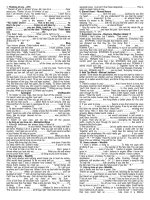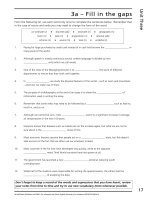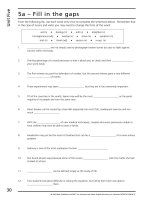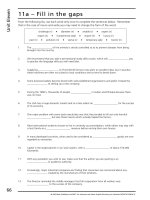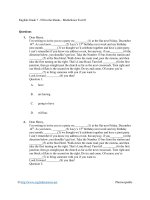English grade 10 fill in the blanks multichoice test 03
Bạn đang xem bản rút gọn của tài liệu. Xem và tải ngay bản đầy đủ của tài liệu tại đây (13.49 KB, 3 trang )
English Grade 10 - Fill in the Blanks - Multichoice Test 03
Questions
1.
All early television was broadcast in black and white. Color television was possible
but it was too (1) ______ and of very poor quality until the middle of the 1950s. Color
television broadcasts began in the United States in 1954, in Japan in 1960, and in
Europe in 1967.
The first (2) ______ on the moon was broadcast live on television in 1969, and now
television programs are transmitted all over the world immediately through the use of
satellites that transmit the signals from the earth, through (3) ______, and back to the
earth.
More people now (4) ______ their news and information through television than
through newspapers and radio. The development of television is one of the most rapid
and exciting (5) ______ of our century.
Question 01:
2.
A.
bulky
B.
complicated
C.
expensive
D.
valuable
All early television was broadcast in black and white. Color television was possible
but it was too (1) ______ and of very poor quality until the middle of the 1950s. Color
television broadcasts began in the United States in 1954, in Japan in 1960, and in
Europe in 1967.
The first (2) ______ on the moon was broadcast live on television in 1969, and now
television programs are transmitted all over the world immediately through the use of
satellites that transmit the signals from the earth, through (3) ______, and back to the
earth.
More people now (4) ______ their news and information through television than
through newspapers and radio. The development of television is one of the most rapid
and exciting (5) ______ of our century.
Question 02:
A.
arriving
©
Photocopiable
3.
B.
flying
C.
landing
D.
moving
All early television was broadcast in black and white. Color television was possible
but it was too (1) ______ and of very poor quality until the middle of the 1950s. Color
television broadcasts began in the United States in 1954, in Japan in 1960, and in
Europe in 1967.
The first (2) ______ on the moon was broadcast live on television in 1969, and now
television programs are transmitted all over the world immediately through the use of
satellites that transmit the signals from the earth, through (3) ______, and back to the
earth.
More people now (4) ______ their news and information through television than
through newspapers and radio. The development of television is one of the most rapid
and exciting (5) ______ of our century.
Question 03:
4.
A.
space
B.
atmosphere
C.
distance
D.
distance
All early television was broadcast in black and white. Color television was possible
but it was too (1) ______ and of very poor quality until the middle of the 1950s. Color
television broadcasts began in the United States in 1954, in Japan in 1960, and in
Europe in 1967.
The first (2) ______ on the moon was broadcast live on television in 1969, and now
television programs are transmitted all over the world immediately through the use of
satellites that transmit the signals from the earth, through (3) ______, and back to the
earth.
More people now (4) ______ their news and information through television than
through newspapers and radio. The development of television is one of the most rapid
and exciting (5) ______ of our century.
©
Photocopiable
Question 04:
5.
A.
have
B.
have
C.
take
D.
bring
All early television was broadcast in black and white. Color television was possible
but it was too (1) ______ and of very poor quality until the middle of the 1950s. Color
television broadcasts began in the United States in 1954, in Japan in 1960, and in
Europe in 1967.
The first (2) ______ on the moon was broadcast live on television in 1969, and now
television programs are transmitted all over the world immediately through the use of
satellites that transmit the signals from the earth, through (3) ______, and back to the
earth.
More people now (4) ______ their news and information through television than
through newspapers and radio. The development of television is one of the most rapid
and exciting (5) ______ of our century.
Question 05:
A.
problems
B.
facts
C.
events
D.
Issues
©
Photocopiable
